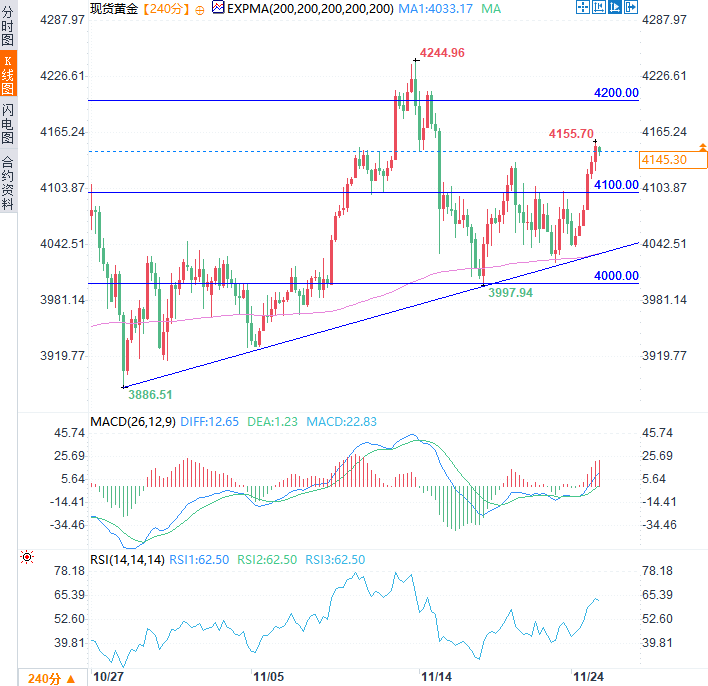Gold prices climbed to a more than one-week high, driven by rising expectations of a Federal Reserve rate cut and geopolitical risks.
2025-11-25 13:06:31

Besides monetary policy factors, the ongoing Russia-Ukraine conflict and the newly erupted armed confrontation in the Middle East together constitute another driving force supporting safe-haven gold.
However, the generally strong global stock market sentiment has somewhat dampened aggressive buying in gold. Market sentiment remains cautious, with investors closely watching key US macroeconomic data to be released this week—primarily the Producer Price Index (PPI) and retail sales figures later on Tuesday—which may provide new trading direction.
Gold prices rose, supported by rising expectations of a December rate cut by the Federal Reserve.
New York Fed President John Williams said last Friday that a near-term rate cut would not jeopardize the Fed's inflation target. On Monday, Fed Governor Christopher Waller further pointed out that the weakness in the labor market already supports another 25 basis point rate cut in December.
According to the CME FedWatch Tool, the futures market is currently pricing in an 80% probability of a 25 basis point rate cut in December to the 3.50%-3.75% range. This expectation has effectively curbed the recent rebound of the US dollar to its highest level since late May (100.39), creating a favorable environment for gold assets with zero yield. The US dollar index fluctuated around 100.15 on Tuesday.
Russia launched a new round of attacks on the Ukrainian capital, Kyiv, early Tuesday morning, targeting residential buildings and energy infrastructure. This military action coincided with negotiations between U.S. and Ukrainian representatives in Switzerland over the weekend regarding a U.S.-brokered ceasefire.
The White House stated that President Trump remains hopeful of reaching an agreement, but acknowledged that progress remains uncertain. Ukrainian officials revealed that the US version of the Russia-Ukraine peace plan has now been reduced to 19 articles and does not include any hard limits on the size of the Ukrainian army.
Adjustments to the plan may reduce Russia's acceptance. Furthermore, according to statistics from the Gaza government's media office, Israel has violated the US-brokered ceasefire agreement at least 497 times in 44 days. Continued geopolitical risks are another key factor supporting safe-haven assets.
Markets are focused on Tuesday's US economic data: the delayed Producer Price Index (PPI) and retail sales data may influence the dollar's trajectory and create short-term trading opportunities for gold.
Gold prices appear poised for further gains, potentially targeting a retest of the $4,200 level.
The significant overnight rebound confirmed the validity of the $4030-$4040 confluence support zone – a zone formed by the upward trendline extending from late October and the 200-period exponential moving average (EMA, 4036.37) on the 4-hour chart.
With gold prices subsequently rising, and the 4-hour and daily chart oscillators in positive territory, it indicates that gold prices have further upward momentum in the short term. This means that gold prices are likely to test the $4177-$4178 area and move towards the $4200 level. If the momentum continues, it may further test the monthly high near $4244.96.
On the downside, if gold prices fall below the $4130-$4132 area, it could be seen as a buying opportunity, with strong support expected in the $4110-$4100 area. A decisive break below this support zone would test the key confluence support in the $4030-$4040 area; a breach here would turn the short-term trend bearish, potentially pushing gold prices towards the psychological level of $4000.

(Spot gold 4-hour chart, source: FX678)
At 13:06 Beijing time, spot gold was trading at $4143.01 per ounce.
- Risk Warning and Disclaimer
- The market involves risk, and trading may not be suitable for all investors. This article is for reference only and does not constitute personal investment advice, nor does it take into account certain users’ specific investment objectives, financial situation, or other needs. Any investment decisions made based on this information are at your own risk.





















